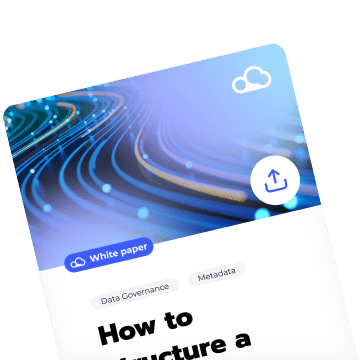Data governance is the process of managing the availability, usability, integrity, and security of the data in enterprise systems. Simply put, data governance covers all the rules and processes that ensure organizational data’s structure, protection, and management.
Data is more effective with proper data governance: Data management is indispensable for analytics, and it enables your company to make better, more informed decisions. Additionally, good data governance ensures that the data you and your teams use is correct, consistent, and accessible to the right people in the company.
Data governance enables you to:
- Gather data from across the enterprise to get a global view
- Identify data sources and processes
- Verify data quality
- Ease data integration
- Ensure compliance with data protection laws and regulations
- Allow the business teams to analyze and present the data
- Educate the company on the need to use data correctly
Without effective data governance, companies run the risk of data consistency issues, which in turn results in unreliable enterprise and business intelligence reporting.
Do you need a data governance strategy?
If you are concerned about any of the following issues, then implementing a data governance strategy can help your business:
- Analyze your data in greater detail
- Make data-driven decisions to keep up with competition
- Keep up with security regulations requires strict control of your data
- Remove duplicates, incorrect, and obsolete data
- Recognize and mitigate security problems
- Manage several databases
Implementing organizational data governance in 3 easy steps
#1: Inventory and map the company’s data
The first step to establishing data governance is knowing where the company’s data is stored and identifying it. Next, you can look at its lifecycle within the enterprise: What is the use of the data? How is it transformed? By whom?
A data catalog is essential to get an overview of all data. Since it brings together all the company’s data, you can map it more efficiently and establish a common overview.
#2: Create a more data-driven organization
The implementation of a data governance plan varies depending on a project’s criticality and the company’s size. In all cases, it is essential to determine the roles and responsibilities of each person in relation to the data. Start by appointing Data Owners: Those who manage the data in their respective business area. It may also be helpful to appoint one or more Data Governance Managers to orchestrate all actions.
#3: Promote and encourage a data culture
Once you have all the tools necessary to manage data, it is important to encourage other business teams to utilize data in their decision-making. It can often be challenging to promote an over-arching data culture and a data-driven approach among your teams. To achieve this, it is useful to:
- Schedule various training sessions for all users
- Facilitate the exchange of information and the dissemination of best practices through a recurring meeting, an idea box on your intranet, or a data newsletter.
How to manage organizational change
When building your governance strategy, it’s important to involve all teams as early as possible: To identify data-related issues, ask the various business units. You can then involve them and convince them to participate in the data governance project.
Best Practices
Establish clear rules
When implementing your data governance strategy, it is likely to run into some resistance along the way, as data governance can restrict how data is handled within the organization. A vital step to ensuring your governance project’s success is establishing clear and comprehensive guidelines. These rules can be outlined by a data governance committee established within your organization.
Provide training
All teams in the company must have the tools to use data effectively. When it comes to data, consistency is vital. Consider carrying out a workshop or training session so that everyone can be on the same page about your data governance objectives.
Communicate clearly & often
Consistent communication throughout all stages of the project is key. Ensure that all project roles and ownership are clearly defined.
Choose the right data catalog
Choosing the right data catalog is perhaps one of the most important factors for your project: Data catalogs are the golden tool for your governance project as they gather all of your organization’s data in one place, making it accessible to all.
Conclusion
Good data governance will protect your company from serious data issues, by ensuring all data in your enterprise is tracked, cataloged, and protected. Without such a plan, it will be more difficult for your business to manage the volume and quality of information that is currently being generated. In the end, your governance project is more than just about ensuring data is reliable: It’s about ensuring that your company has access to all the information it needs to effectively make informed decisions.
—
Do you still have questions about achieving data governance? Turn to DataGalaxy to create your company’s data lineage mapping, develop a standardized business glossary, and much more! Check our calendar and select a date that works for you to jumpstart your free 15-day platform trial access & start making the most of your data today!





